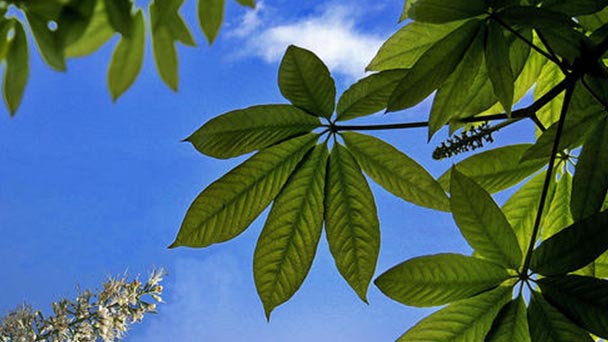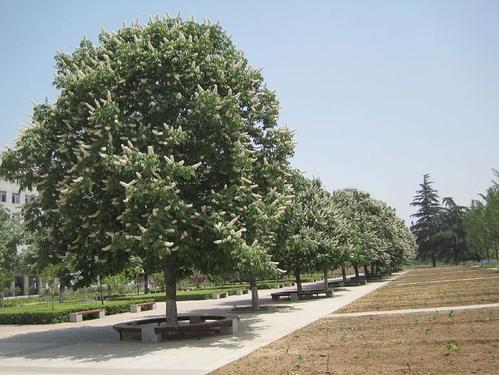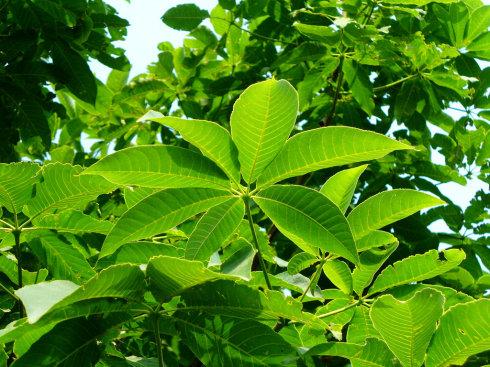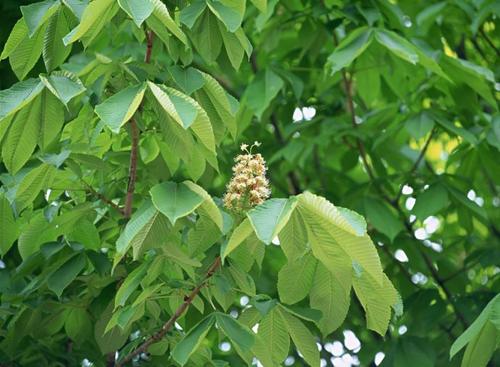Aesculus profile
Written by Maggie
Dec 23 2020

Aesculus seeds are edible, but they taste bitter, boiled in lye, and taste like chestnuts. Starch can also be extracted. Fine wood can be used to make all kinds of utensils, seeds can be used for medicine, oil can be used to make soap. Aesculus is a kind of tree with beautiful shape, beautiful flowers and peculiar fruit shape. It is one of the most famous ornamental tree species in the world.
Aesculus picture

Aesculus morphological characteristics
Aesculus is a deciduous tree, up to 25 m tall, with bark dark brown or grayish brown, branchlets, cylindrical, yellowish brown or grayish brown, glabrous or puberulent when young, with rounded or elliptic pale yellow lenticels. In winter buds are large, resinous. Palmately compound leaves, 5-7 small, petiole 10-12 cm long, grayish pilose; Lobules are papery, oblong-lanceolate to oblong-oblanceolate, thinly oblong-elliptic potassium apex short acute, base cuneate or broadly cuneate, margin obtuse serrate, 8-16 cm long and 3-5 cm wide, dark green above, glabrous, underside glabrous except at base of middle rib and lateral veins tender sparsely pilose; The midrib is prominent above, convex below, lateral veins 13-17 pairs, slightly prominent above, and prominent below;Petioles 1 -- 1.8 cm long in central leaflet, petioles 5 -- 10 mm on both sides, grayish pilose.
The inflorescence is cylindric, 21 -- 2 5 cm long with 5 -- 10 cm peduncle, racemes puberulent, florets often 5 -- 10 flowered, composed, spreading obtuse, puberulent, 2-2.5 cm long, pedicels 2-4 mm long. Flowers are heterogenous, male and bisexual, calyx tubular campanulate, 3-5 mm long, puberulent outside, unequal 5-lobed, lobes obtuse, margin with short cilia; Aesculus has 4 petals, white, oblong-obovate to oblong-oblanceolate, ca. 8 -- 12 mm long, 5 -- 1.5 mm wide, margin ciliated, base clawed; Aesculus has 6 stamens, 1.8-3 cm long, filaments linear, glabrous, anthers oblong, pale yellow, ca. 1-1.5 mm long; The ovary is underdeveloped in male flowers, well developed in bisexual flowers, ovoid, style glabrous.
Aesculus fruit is globose or obovoid, apically short or obtuse and slightly concave in middle, 3-4 cm in diam., yellow-brown, spiny, with dense spots, 5-6 mm thick after dried, seeds often 1-2, nearly spherical, 2-3.5 cm in diam., chestnut brown; Umbilicus are white, about 1/2 of the seed volume. Flowering period is April-May, fruit period October.
Aesculus native Habitats
Aesculus is cultivated in the Yellow River basin and the eastern provinces of China, and only wild in the Qinling Mountains. Aesculus is naturally distributed in the mountains below 700 meters above sea level, the species in the Yellow River basin is excellent road trees and garden trees.
Aesculus growth habits
Aesculus is light-loving and slightly shade tolerant; Aesculus likes the warm climate, also can withstand the cold; Aesculus likes deep, fertile, moist and well-drained soil. The growth rate is medium slant slow, life is long. Aesculus leaves are subject to sunburn during the hot summer months.

Aesculus main value
The botanical garden
Aesculus is an excellent pedestrian and ornamental plant for walking, parks and plazas. It can be planted either alone or in groups, or mixed with evergreen and broadleaf trees. Aesculus is widely cultivated as a street tree and shade tree in Europe, America and Japan. In North America, safflower or pink flowers and double Aesculus horticultural varieties are planted on both sides of roads. The scenery is very beautiful when flowers bloom.
In China, Aesculus is often planted alone or in front of buildings and between open forests. Chinese heptadidae tree species are abundant and widely distributed, but most of them are still in the stage of not being properly managed and utilized.
Medicine
Seed (Borneo) : sweet and warm, stomach pain. It’s used for liver and stomach gas pain, epigastric abdominal distension, premenstrual abdominal pain, breast distension, infantile parasitism pain, dysentery.
Economic
Aesculus can be used as food, medicine, wood, etc. Aesculus leaf bud can be used as tea, skin and root can be used as soap, leaves and flowers can be used as dyes, seeds can be used to extract starch, extract oil, and also used as food. Aesculus has a similar taste to chestnut, and can be used as medicine to calm the mind, kill insects and other functions. The wood is light in texture and can be used for paper making, carving, furniture and arts and crafts.

Latest Updated
- Benefits of Bugleweed - 7 Science-backed Health Benefits
- Bugleweed Dangers & Side Effects - Is It Poisonous?
- How to Plant Evergreen Trees - What You Should Know
- When to Plant Evergreens - Grow Guide for Evergreen Trees
- 12 Wonderful Evergreen Shrubs for Your Garden
- 12 Popular Evergreen Plants with Pictures for Beginners
- When And How To Prune A Lilac Bush Like a Pro
- How to Grow & Care for Lilac Vine (Hardenbergia Violacea)
- Japanese Lilac Tree (Syringa Reticulata) Care & Propagation Guide
- Shumard Oak Pros and Cons - What to Know
Popular Articles
- Winter maintenance of Antirrhinum Majus
- How to Grow Terminalia Mantaly Tree
- How to Grow and Care for Crossostephium Chinense
- How to grow Antirrhinum Majus in spring
- Peristeria Elata (Dove Orchid) Profile: Info & Care Guide
- Underwatered Snake Plant (Sansevieria Trifasciata) - Signs And How To Fix
- How to Care for Brazilian Jasmine Plant (Mandevilla Sanderi)
- How to Grow & Care for Graptopetalum Purple Delight in Summer
- Rosa Chinensis (China Rose): Plant Growing & Care Tips
- How to Care for Baby Sun Rose (Aptenia Cordifolia)